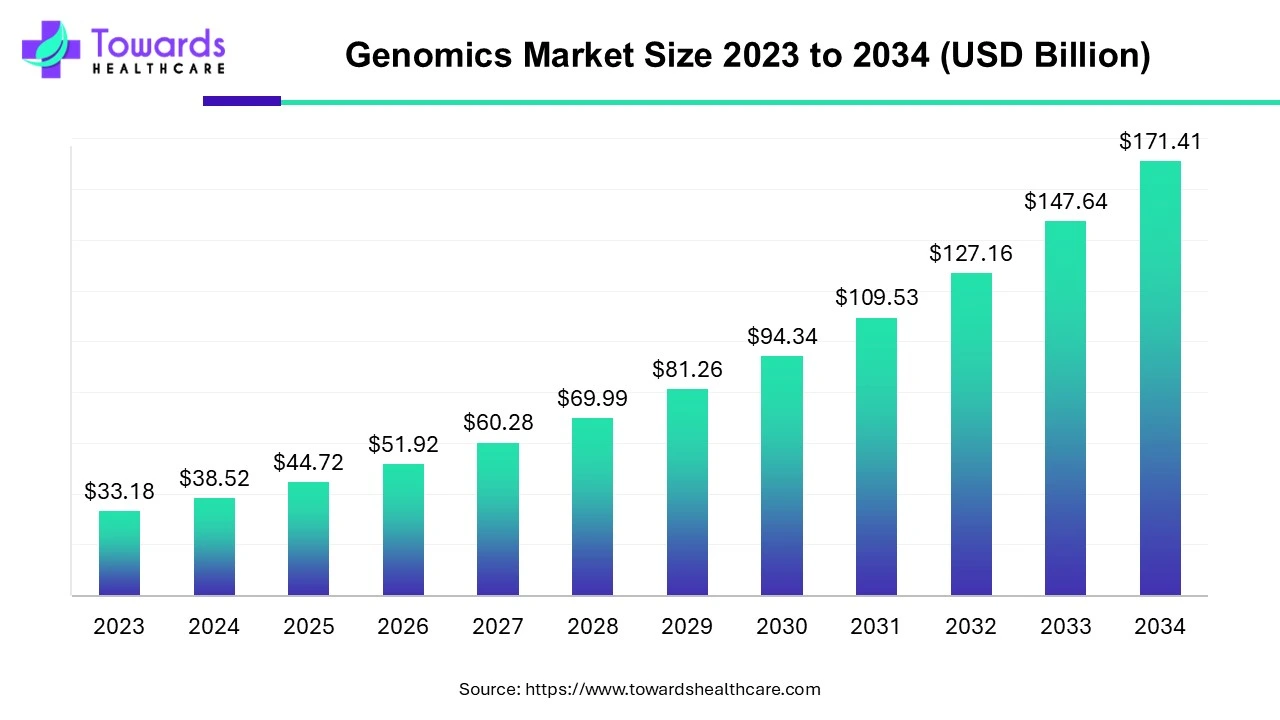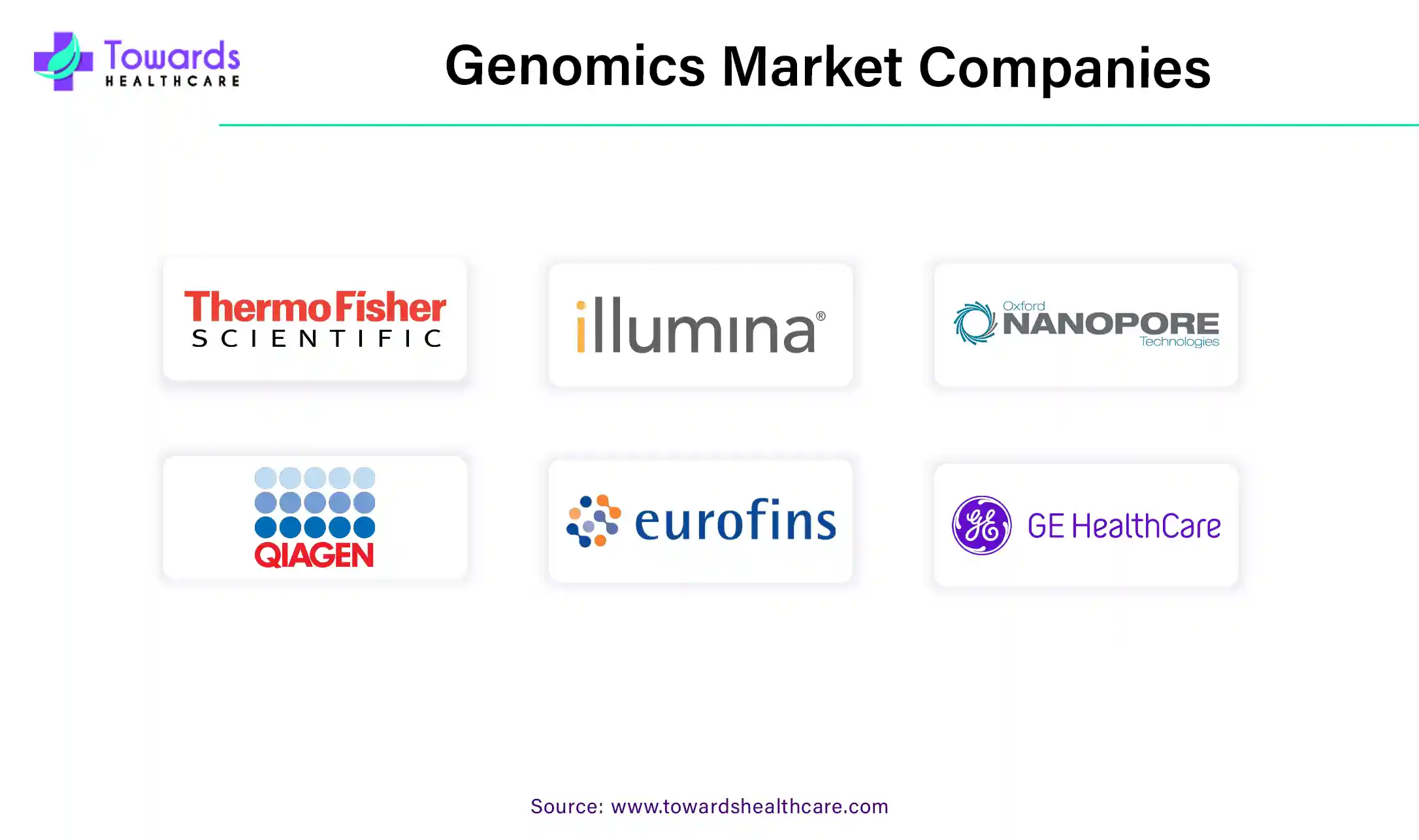March 2025


Principal Consultant

Reviewed By
The global genomics market size is projected to reach USD 171.41 billion by 2034, expanding from USD 44.72 billion in 2025, at an annual growth rate of 16.1% during the forecast period from 2025 to 2034, as a result of rising technology advancements and increasing demand for personalized medicine.

Precision medicine adoption and genomic data integration for personalized care are paving the market growth.
Genomics, the study of an individual's genetic material, plays a crucial role in understanding the genetic basis of diseases, developing targeted therapies and enabling precision medicine. The genomics market is experiencing rapid growth and transformation, driven by advancements in technology, decreasing sequencing costs, and the increasing demand for personalized medicine.
The market encompasses various technologies including next-generation sequencing (NGS), polymerase chain reaction (PCR), microarray analysis, and gene editing tools like CRISPR-Cas9. These technologies enable researchers and clinicians to analyze and interpret genetic information, providing valuable insights into disease mechanisms, drug discovery, and patient care.
The genomics market is witnessing significant growth due to the increasing prevalence of genetic disorders, the rising adoption of genomic medicine in clinical practice, and the expanding applications of genomics in areas such as oncology, rare diseases, pharmacogenomics, and agriculture.
Data analytics techniques, such as machine learning and artificial intelligence, play a crucial role in genomics research and clinical applications. These techniques can analyze large-scale genomic datasets, identify patterns, and generate predictive models for disease diagnosis, prognosis, and treatment response. They can determine thousands of 3D genome structures quickly. This leads to enhanced accuracy and precision, saving a lot of time for researchers. Thus, genomics can significantly simplify the task of researchers, reducing manual errors. Apart from research, AI in genomics has applications in the clinical field. The integration of genomics data with electronic health records (EHRs) and other clinical data sources enhances the understanding of genotype-phenotype correlations. This integration enables clinicians to make informed decisions based on comprehensive patient information, improving diagnosis accuracy, treatment selection, and disease management.
The growing prevalence of genetic diseases is a significant driving factor for the genomics market. Genetic diseases, such as cancer, cardiovascular disorders, rare genetic disorders, and inherited diseases, have a substantial impact on global health. According to the World Health Organization, there are approximately 10,000 different types of single-gene diseases, also known as monogenic diseases, caused by mutations in a single gene. It is estimated that around 10 out of every 1000 people are affected by these diseases, resulting in a global population of approximately 70 million to 80 million individuals living with these conditions. The increasing understanding of the genetic basis of these diseases has led to a rise in demand for genomic solutions and services.
The increasing prevalence of genetic disorders has contributed to the growth of this market. For instance, as of January 2023, approximately 6,000 babies are born with Down syndrome in the United States each year, accounting for about 1 in every 700 births. The total number of diagnosed individuals with Down syndrome in the U.S. is around 200,000. Genomics plays a crucial role in diagnosing, predicting, and treating genetic diseases. It enables the identification of genetic variants and alterations associated with specific diseases, facilitating personalized medicine approaches. Genomic sequencing technologies allow for the comprehensive analysis of an individual’s genetic makeup, providing insights into disease risk, drug response, and potential treatment options.
The application of genomics in genetic disease research and clinical practice has expanded significantly in recent years. Market players are developing advanced genomic tools, platforms, and services to cater to this growing demand. This includes next-generation sequencing (NGS) technologies, microarray-based genotyping, and bioinformatics solutions for data analysis and interpretation.
Additionally, the decreasing costs of genomic sequencing and the availability of large-scale genomic databases have further propelled the adoption of genomics in healthcare. This has made genetic testing and genomic profiling more accessible and affordable for both healthcare providers and patients. The growing prevalence of genetic diseases also underscores the importance of genomics in population health management and public health initiatives. Genomic screening programs, carrier testing, and newborn screening are being implemented to identify individuals at risk of genetic diseases and initiate appropriate interventions.
Advancements in bioinformatics and data analytics are another major driver in the genomics market. The field of genomics generates vast amounts of data, including genomic sequences, gene expression profiles, and clinical data. Effectively managing, analyzing, and interpreting this data is critical for unlocking the full potential of genomics. Bioinformatics tools and platforms enable researchers and clinicians to analyze and interpret genomic data, identify genetic variations, and understand their functional implications. These tools facilitate the discovery of disease-associated genes, biomarkers, and potential therapeutic targets.
Bioinformatics and data analytics also support population-scale genomics initiatives, such as large-scale sequencing projects and biobanks. These initiatives aim to build extensive genomic databases, allowing researchers to explore genetic variations across diverse populations and identify population-specific disease risk factors.
Thus, bioinformatics and data informatics are driving the genomics market by providing essential tools, algorithms, and expertise for efficient data management, analysis, and interpretation. Their contributions are vital for unlocking the potential of genomic data and translating it into meaningful insights for personalized medicine, drug discovery, and improved patient outcomes.
Despite the significant advancements in genomics, there are several challenges and restraints that hinder market growth. One major restraint is the complexity of genomic data interpretation and the limited understanding of the functional implications of genetic variations. Genomic data is incredibly complex, consisting of billions of nucleotide sequences and a vast number of genetic variations. Interpreting this data and identifying clinically relevant variations require sophisticated bioinformatics tools, databases, and expert knowledge. The limited availability of skilled bioinformaticians and genomic data analysts poses a significant challenge in harnessing the full potential of genomics.
Additionally, the functional impact of many genetic variations remains poorly understood. While genomic sequencing can identify genetic variations, determining their functional significance and clinical relevance is complex. The lack of comprehensive functional annotation databases and standardized guidelines for variant interpretation presents challenges in translating genomic data into actionable clinical insights.
Furthermore, the integration of genomics into routine clinical practice faces barriers such as regulatory requirements, reimbursement policies, and ethical considerations. Regulatory frameworks for genetic testing and genomic medicine vary across countries, making harmonizing practices and ensuring quality standards challenging. Reimbursement policies for genomic testing and personalized therapies are still evolving, creating uncertainties for market players and limiting access to genomics-based diagnostics and treatments.
Moreover, ethical considerations surrounding genomic data privacy and patient consent pose challenges in genomic research and clinical implementation. Safeguarding patient privacy, ensuring informed consent, and maintaining data security are critical for maintaining public trust and facilitating the responsible use of genomic data. As the genomics market continues to grow, PCR technology is expected to play a vital role in enabling precise and targeted genomic analysis. Advancements in PCR methodologies, including the introduction of novel enzymes and improvements in instrument capabilities, further contribute to the expansion of the genomics market and its applications.
The PCR technology holds the largest market share and is projected to be the fastest-growing technology over the forecast period. The genomics market is driven by various technologies, and one prominent technology in this field is Polymerase Chain Reaction (PCR). PCR is a widely used technique that allows for the amplification and analysis of specific DNA sequences. It plays a crucial role in genomics research and applications.
In the genomics market, PCR technology has witnessed significant advancements, leading to the development of various PCR-based techniques. These include real-time PCR (qPCR), digital PCR (dPCR), reverse transcription PCR (RT-PCR), and multiplex PCR, among others. Each technique has its advantages and applications, catering to different research and diagnostic needs. The adoption of PCR technology in the genomics market is driven by factors such as its accuracy, versatility, and cost-effectiveness. PCR-based assays are extensively used in academic research, pharmaceutical and biotechnology companies, clinical laboratories, and forensic laboratories.
By application, the functional genomics segment held a dominant presence in the genomics market in 2024. Functional genomics is a molecular biology field to describe gene functions and interactions. Genome editing, genome sequencing, and bioinformatics are the methods of functional genomics. Functional genomics is widely used in drug discovery, understanding disease, and developing new strategies for disease prevention. The ability to analyze gene expression in the entire genome or a large number of genes increases the demand for functional genomics. The growing research and development activities to identify the cause of disease progression also potentiate the segment’s growth.
By application, the pathway analysis segment is predicted to witness significant growth in the market over the forecast period. Pathway analysis is a combination of genomics and statistics to analyze high-throughput genetics data. The rapidly expanding bioinformatics sector and growing drug discovery research promote the segment’s growth. Pathway analysis provides a deeper understanding of biological processes through gene interactions with known biological pathways. It is an essential tool for biological and proteomics researchers as it provides information about proteins and genes.
By deliverables, the product segment held the major share of the genomics market in 2024. Numerous market players offer genomics products to conduct a wide range of genomics research. These products include sequencing kits, microarray kits, instruments, in vitro diagnostics (IVD), etc. The type of experiments conducted defines the products to be used. These products are widely used by researchers in academic institutes or pharmaceutical & biotechnology companies. Products can enable researchers to conduct multiple experiments and refill the components as and when required.
By deliverables, the services segment is anticipated to grow with a steady CAGR in the market during the studied years. Several academic institutes and companies provide genomics services, wherein the researcher has to pay for the services and obtain the results. Services eliminate the need for specialized infrastructure and the presence of skilled professionals to perform complex genomics experiments. Services are more affordable, enabling researchers to focus on their outcomes. All these aspects augment the segment’s growth.
By end-user, the pharmaceutical & biotechnology companies segment led the global market in 2024. The segmental growth is attributed to the increasing number of patents, the presence of trained professionals, and suitable infrastructure. Favorable regulatory frameworks lead to new product launches, encouraging companies to develop more novel therapeutics. The U.S. FDA has approved a total of 15 gene therapy products, as of December 2024. New product launches also help companies to strengthen their market position.
By end-user, the hospitals & clinics segment is estimated to show lucrative growth in the market in 2024. The rising incidences and prevalence of chronic disorders lead to an increasing number of hospitalizations, propelling the segment’s growth. Hospitals and clinics have suitable capital investment to adopt advanced genomics tools as therapeutics or diagnostics. Favorable reimbursement policies also fuel the segment’s growth.
North America, particularly the United States, dominates the genomics market and holds the largest market share. The region's leadership can be attributed to factors such as strong research infrastructure, significant investments in genomics research, and the presence of key market players. The United States has a robust genomics ecosystem, including academic research institutions, pharmaceutical companies, and genomics service providers. Specifically, the National Human Genome Research Institute (NHGRI) has been allocated a budget of $639 million, reflecting a 3.8% increase compared to the previous year.
The country has been at the forefront of large-scale genomics initiatives, such as the Precision Medicine Initiative and the All of Us Research Program, driving the adoption of genomics in healthcare. In addition to the United States, Europe is a prominent market for genomics, with countries like the United Kingdom, Germany, and France leading in terms of research and clinical implementation. Europe has a strong regulatory framework for genetic testing and personalized medicine, supporting the integration of genomics into healthcare systems.
Asia-Pacific is a rapidly growing market for genomics, driven by increasing investments in genomics research, the rising prevalence of genetic diseases, and the expanding demand for personalized medicine. Countries like China, Japan, and India are making significant strides in genomics research, fueling market growth in the region. In the upcoming years, Asia-Pacific is projected to be the fastest-growing region in the genomics market. The region's large population, growing healthcare infrastructure, and government initiatives to promote genomics research and precision medicine contribute to its growth potential. The increasing focus on precision healthcare and personalized medicine in emerging economies presents lucrative opportunities for market players in the region.
One major opportunity in the genomics market lies in the integration of genomics with other -omics technologies, such as proteomics, metabolomics, and transcriptomics. The combination of these technologies, often referred to as multi-omics approaches, allows for a comprehensive understanding of biological systems and disease mechanisms. By integrating genomics with other -omics data, researchers can gain insights into the complex interplay between genes, proteins, metabolites, and other molecular components. This integrative approach can provide a more holistic view of disease processes, identify novel biomarkers, and facilitate the discovery of new therapeutic targets. For example, integrating genomics with proteomics can enable researchers to identify protein biomarkers associated with disease progression, drug response, and treatment resistance. This information can be valuable for developing targeted therapies and monitoring treatment efficacy.
Similarly, combining genomics with metabolomics can shed light on the metabolic pathways influenced by genetic variations and their impact on disease development. This integrated approach can enhance our understanding of personalized nutrition, drug metabolism, and disease susceptibility. Furthermore, the integration of genomics with transcriptomics allows researchers to explore gene expression patterns and regulatory networks. This integration can uncover key genes involved in disease pathways, identify dysregulated pathways, and predict disease outcomes.
The integration of multi-omics approaches holds immense potential in advancing precision medicine. By combining multiple layers of molecular information, clinicians can develop personalized treatment strategies tailored to an individual’s unique molecular profile. This approach can improve treatment outcomes, minimize adverse effects, and optimize therapy selection.
Market players can capitalize on this opportunity by developing comprehensive -omics platforms, advanced bioinformatics tools, and data integration algorithms. By offering integrated solutions that combine genomics with other-omics technologies, market players can cater to the growing demand for holistic molecular insights in research, diagnostics, and therapeutic development.

Ben Hindson, Co-Founder and Chief Scientific Officer of 10x Genomics, commented on the launch of its series of new product innovations that the company continues to push the boundaries of single-cell and spatial biology. He also said that the company’s 2025 roadmap will raise the bar for the field and enable researchers to tackle bigger questions, analyze more samples, and extract deeper insights from their data.

By Technology
By Application
By Deliverables
By End-Use
By Region
March 2025
March 2025
March 2025
March 2025